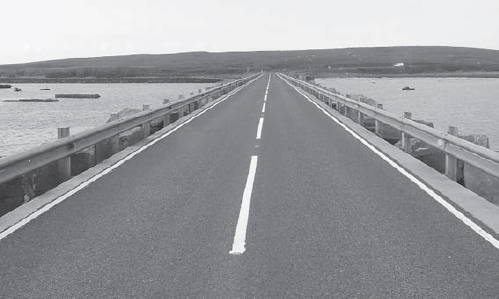
While for decades the Orcadians might have cursed the remnants of Scapa Flow’s wartime defences as blight on the landscape, today these remains are regarded with more tolerance. Since the end of World War II these sites reverted to civilian use, and some buildings were even used as homes, most notably at Hatston near Kirkwall, where the buildings of HMS Sparrowhawk were used as temporary housing by the local council, and remained in use until the 1970s. Elsewhere farmers used wartime buildings as farm steadings, while remote searchlight emplacements and gun batteries became useful livestock shelters. Today traces of these defences can be seen all over Orkney, making a landscape as rich in wartime history as it is in Neolithic pre-history.
Many of the coastal gun batteries have survived virtually intact, although the camps which once supported them have long since been dismantled. Today their empty searchlight positions, gun emplacements and battery observation posts provide the most vivid reminder of Orkney’s wartime past. Of these the battery sites at Stanger Head, Roan Head and Neb in Flotta, Hoxa and Balfour in South Ronaldsay and Rerwick Head in Tankerness have been opened to public access, allowing ramblers to explore their remains. The Houton Battery is also easily accessible, while the Links Battery outside Stromness now lies beside a road leading to a popular coastal viewpoint over Hoy Sound.
Most other battery sites, such as Carness, Holm, Burray and Deerness, are on private land, and visitors should ask permission from the local farmer before exploring the sites. The Ness Battery outside Stromness is still owned by the Ministry of Defence, who deny the public access to the site. Some of these batteries are no longer safe to enter, particularly those at Hoxa and Carness, where the past seven decades of Orkney weather have done little to improve the condition of the concrete emplacements.
Lyness Naval Base is now the site of a small museum, and the wharf there serves as Hoy’s main ferry terminal. While traces of the base can still be seen, and several original buildings survive, the area has a melancholy air, as those buildings that remain stand amid the concrete scars of the once-bustling naval base. All but one of the oil storage tanks have been dismantled, although it at least has been preserved and has now been ingeniously transformed into part of the museum. In the early 1970s the nearby island of Flotta was transformed when it became the site of an oil terminal, the terminus of a pipeline running from the oilfields of the North Sea. However, traces of Flotta’s wartime remains still exist, including the bare walls of the garrison theatre, and the intriguing remains of the rocket batteries on Roan Head. Oil tankers now ride at anchor in Scapa Flow where once the main fleet anchorage once lay, immediately to the north of Flotta. Few of the tanker crews would realize that one of the buoys in the anchorage marks the last resting place of HMS Vanguard, while a few miles to the north-east another buoy lies over the hulk of HMS Royal Oak.

Churchill Barrier No. 3, spanning Weddel Sound between the islands of Glims Holm (seen in the distance) and Burray. As Italian POWs were forbidden to work on defensive structures, the road built on top turned these anti-shipping barriers into a project designed to improve communications between the islands. (Author’s collection)
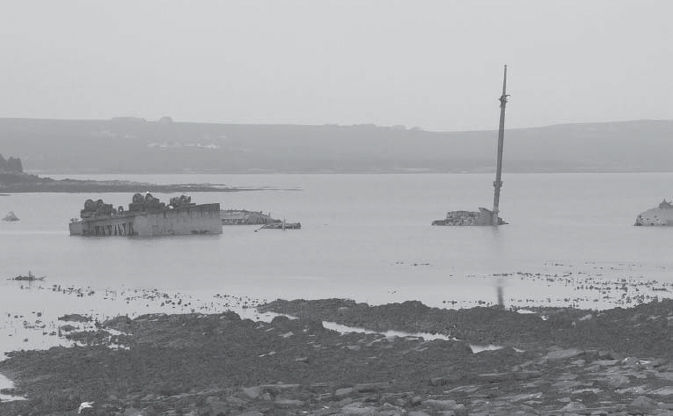
The remains of the blockship SS Lycia, which was sunk in Skerry Sound between Lamb Holm and Glims Holm in 1939. While these blockships sealed off most of the small, eastern channels into Scapa Flow, in October 1939 U-47 still managed to pick her way past the blockships in Kirk Sound and enter the naval anchorage which lay beyond (Author’s collection).
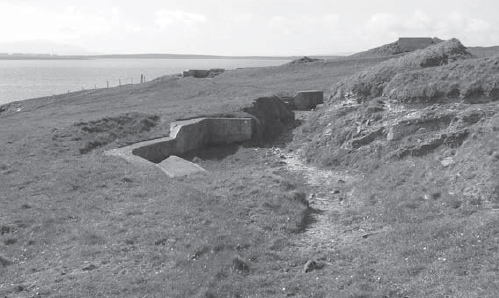
While the 6in. gun emplacements on Hoxa Head dating from World War I were built over in 1939, these 4in. emplacements a little to the north were left untouched. They are built in a similar manner to the Ness Battery near Stromness. (Author’s collection)
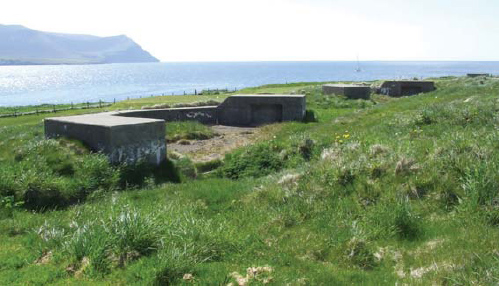
Ness Battery No. 3, overlooking Hoy Sound just outside Stromness. Today the three 4in. gun positions dating from World War I are incorporated into part of the rough of Stromness Golf Club. (Author’s collection)
These aren’t the only warships to lie in Scapa Flow. Today the remains of the German High Seas Fleet, which was scuttled in 1919, is one of the most popular wreck diving attractions in the world, and every year these sites are visited by thousands of scuba divers. The wrecks of three battleships – the König, Kronprinz Wilhelm and Markgraf – and four cruisers – Brummer, Karlsruhe, Köln (II) and Dresden (II) – are all that remain of the age of the dreadnought. Actually, that isn’t quite true. Today the wrecks constitute one of the world’s best reserves of non-radioactive steel, as metal from the ships doesn’t contain the radioactive isotopes found in post-1945 steel. As a result elements of ‘Scapa Steel’ were used in the construction of the space probe Voyager, which means that a small remnant of the dreadnought era still has an important place in mankind’s technological quest.
The military airfields of Orkney have long gone, and while few traces of Skeabrae remain the control tower of Twatt still stands sentinel over an airfield that has now been turned over to pasture. Hatston is now an industrial estate and cruise ship terminal, although visitors can still find traces of its tarmac runways and fighter dispersal bays towards its western edge. As a child the author used to launch sailing dinghies from the Hatston slipway where Walrus seaplanes were once brought ashore, and this crumbling concrete ramp is one of the few remaining traces of the old airfield that still remains in use today. By contrast, Grimsetter airfield to the south-east of Kirkwall was turned over to civilian use, and is now the site of Kirkwall Airport. As late as the early 1970s the airport buildings were adapted from wartime Nissen huts, but today a new terminal building stands in their place, and few traces remain of the old wartime airfield, save the odd grass-covered fighter dispersal bay or overgrown air-raid shelter on the coastal fringes of the modern airport.
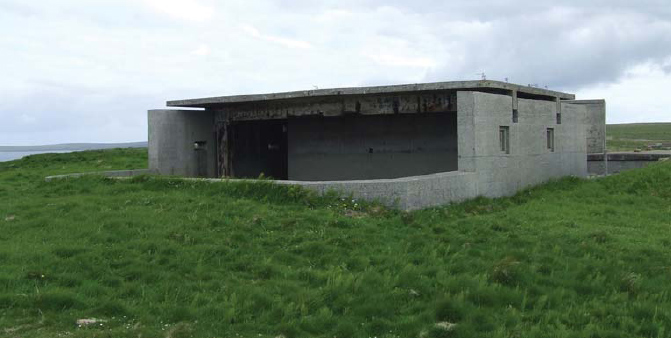
This emplacement at Rerwick Head in Tankerness once housed a 6in. BL Mark VII gun, one of two large gun positions in the battery. The 6in. guns were installed in March 1941, replacing two 4.7in. QF pieces which had been installed in the battery after being removed from the aged dreadnought HMS Iron Duke. (Author’s collection)

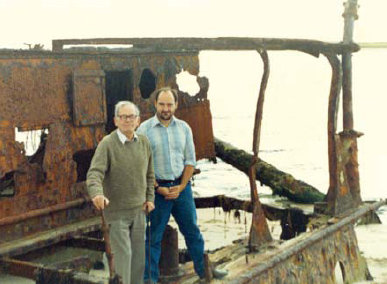
Since the building of Churchill Barrier No. 4 the 1,017-ton steamer SS Carron, which was sunk as a blockship in Water Sound in 1940 has gradually been covered by sand. The first picture taken in 1972 shows the author (left) playing on the wreck. The second picture of the author and his father Peter Konstam was taken in 1993, by which time the sand had reached the level of the upper superstructure. The third shows only a few feet of mast remaining above the sand. (Author’s collection)
Today few Orcadians can imagine life without the Churchill Barriers, providing access between the Orkney Mainland and the charming south isles of Burray and South Ronaldsay. Like Stromness in the West Mainland, the small village of St Margaret’s Hope in South Ronaldsay is now a major ferry terminal, linking Orkney to the mainland of Scotland. The route takes the ferry through the once heavily defended waters of Hoxa Sound, beneath the now-silent gun batteries of Hoxa and Stanger heads and the last resting place of the U-116. In fact it is almost impossible to approach Orkney by sea without passing the empty mouths of gun batteries.
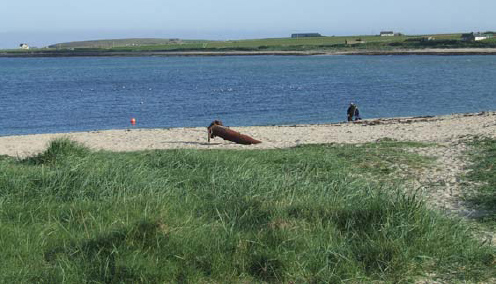
Once passengers land at St Margaret’s Hope the drive to Kirkwall takes less than half an hour, taking them across the concrete block-lined Churchill Barriers, the last of which crosses Kirk Sound, where U-47 stole silently into Scapa Flow on that October night some 70 years ago. Overlooking Kirk Sound is the Italian Chapel, the last remnant of the Italian prisoner-of-war camp on Lamb Holm, one of two such camps in the South Isles and the home of the men who worked on the barriers. Today it is a small Catholic chapel, lovingly restored by former prisoners, and a moving symbol of wartime tribulations and achievement. The rusting remains of blockships still lie close to the barriers, although in many cases the build-up of sand or the decay of salt water have made them far less impressive than they once were. However, they still block the eastern approaches to Scapa Flow, overlooked by the remains of gun emplacements and dwarfed by the Churchill Barriers, which remain the most impressive, as well as the most practical modern reminder of Orkney’s wartime past.
Scapa Flow Visitor Centre & Museum, the Old Pumping Station, Lyness, Hoy Built inside the old wartime oil pumping station and the one surviving oil fuel tank at Lyness, the museum traces the story of wartime Scapa Flow using displays and exhibits, while the tank itself now provides a setting for a large object display area and a film theatre where the history of Scapa Flow is explained. Open throughout the year.
Orkney Museum, Tankerness House, Broad Street, Kirkwall
Contains displays about 5,000 years of Orkney history, including the impact of both world wars on the community.
Open throughout the year.
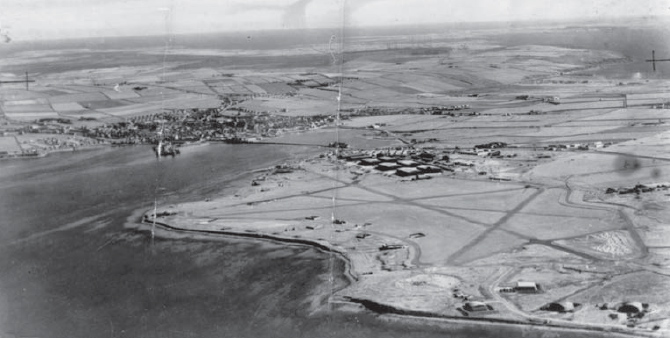
Kirkwall, the principal town in Orkney, from an aerial photograph taken during World War II. In the foreground is HMS Sparrowhawk, the Royal Naval Air Station at Hatston, while the masts of the Netherbutton radar station at Netherbutton can be seen in the right middle distance. On the far right is Scapa Bay, the most northerly arm of Scapa Flow. (Orkney Library & Archives)
Stromness Museum, 52 Alfred Street, Stromness
The museum contains an extensive series of exhibits on Scapa Flow, with a particular emphasis on the scuttling of the German High Seas Fleet.
Open throughout the year.
Wireless Museum, Kirkwall, Kiln Corner, Junction Road, Kirkwall A small but fascinating private museum, tracing the story of wartime communications in Orkney, and containing important wartime memorabilia Opening times vary.